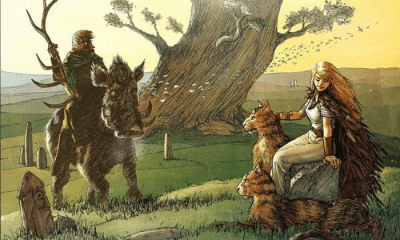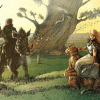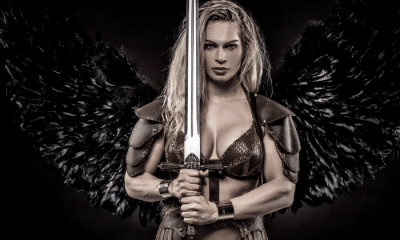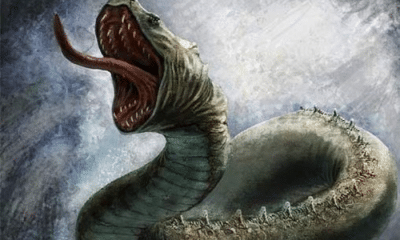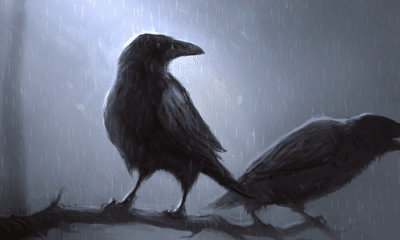Norse
Where was Midgard?
One of the Nine Worlds that lay among the branches of the great World Tree, Midgard was the safe home of mankind in Norse Mythology.
If you’ve ever wondered where modern fantasy writers got the term “Middle Earth” from, the answer lies in the ancient beliefs of Scandinavia.
In Norse cosmology, Midgard was the “middle yard” of the Nine Worlds. Like elves, dwarves, and gods, humans had their own world that was uniquely suited to their lifestyle.
The Norse people had a story for how their world was created by the gods, but they also believed that many neighboring worlds had been made in different ways.
Midgard, however, provided a safe haven for humanity. Protected from outside forces, it would only be destroyed when Ragnarök destroyed the gods, as well.
Midgard and the Nine Worlds
In Old Norse cosmology, Midgard was one of nine worlds. All nine existed along the length of Yggdrasil, the World Tree.
Midgard was somewhere in the center, which is made clear by its translation as “middle yard.” It is traditionally said to have been placed between Niflheim, the land of ice, and Muspelheim, the land of fire, although no surviving writings precisely lay out the worlds and their locations.
The world of Midgard was that which was always visible to living people. The other worlds could sometimes be glimpsed or viewed by humans, but Midgard was the only one that was completely visible.
In the Norse story of creation, Midgard was formed by the gods from the body of Ymir, the father of all jötnarr. The jötnarr, sometimes mistakenly called giants in English, had their own world but constantly threatened the humans of Midgard.
To protect against this, the gods used Ymir’s eyebrows to create a protective wall that encircled the world. This wall itself was sometimes referred to as Midgard.
The land of Midgard was formed from Ymir’s flesh. His blood was the oceans, his teeth and bones were mountains and cliffs, and his hair made the trees and grasses.
In some cosmologies, the sky was a separate world from the Earth. The Norse, however, believed that the sky was part of Midgard as well.
It was Ymir’s skull, held aloft by four dwarfs that represented the cardinal directions. His brains were the clouds and the stars were sparks that lit up within his mind.
Midgard was connected to Asgard, the home of the Aesir gods, by the rainbow bridge Bifröst. This bridge could only be accessed with permission, however, as it was guarded at all times by the watchful god Heimdall.
The Norse also believed that Midgard would be the site of Ragnarök, the great battle that would destroy both the gods and the known world. The land would sink into the ocean and almost all life would be destroyed, but new land would eventually rise again to begin a new age of creation.
My Modern Interpretation
Many ancient cosmologies centered around the idea that there was more than one world, but the Norse cosmology was unique in its view of how the worlds related to one another.
It is common for the world of men to exist in the center. In Greco-Roman mythology, for example, Gaia (the Earth) is beneath Uranus (the heavens) and above Tartarus (the Underworld).
This three-part cosmology generally divides creation between the divine, the living, and the dead.
Norse mythology, however, imagined the known world that was visible to men as one of many worlds. While the common three realms existed along Yggdrasil, six more realms were added.
This is due to the fact that the Norse believed that beings other than the gods and the dead had their own worlds that were separate from that of humans. While mankind lived in Midgard, races like the elves and dwarves had their own homes.
Because the worlds were all connected by Yggdrasil, however, the world of men was vulnerable. The jötunn, in particular, were a constant threat.
Because “geard” in Old Norse referred to a yard or enclosed space, Midgard is often thought to be connected to the other realms at the center of Yggdrasil. The wall of Midgard was all that separated it from the lands of the jötunn, elves, and other races.
In this view, the Nine Worlds existed in groups that more closely resembling the cosmologies of many other religions. The primordial extremes of fire and ice were still separate, but between them were realms corresponding to the divine, the living, and the dead.
Humans could not cross the ocean to reach the wall, although a few legends told of such attempts, but the more powerful jötunn could reach the world of men. Midgard, Jötunheim, and the other realms of living creatures were separate worlds but on the same plane.
The plane that housed these worlds was thus divided between the safe space of Midgard and the unknown lands outside of it.
Midgard was a human settlement writ large. Just as walls were built around towns and farms to keep them safe from wild animals or raiding armies, so too was the world of men enclosed as a yard to keep all of humanity safe from what lay outside their settled space.
Norse cosmology seems particularly complex because of the situation of nine separate worlds within the ash tree Yggdrasil. At its heart, however, it reflects the standard divisions between the diving, living, and dead and the human attempt at creating safety in a threatening world.
In Summary
Midgard was the world of the human race in Norse cosmology.
Midgard was one of the Nine Worlds that sprawled along Yggdrasil, the World Tree. It was at the center and connected directly to Asgard, the world of the Aesir gods, by the rainbow bridge Bifröst.
While the other worlds could occasionally be glimpsed or felt from Midgard, it was the only world that was fully visible to the human race. When Norse writers referred to Midgard, they meant the known world as it could be experienced by humans.
It was created by the gods from the body and bones of the Ymir, the ancestor of the jötunn, beings that were neither human nor divine and are sometimes mistakenly referred to as giants in English translations. Jötenheim was nearby, so the jötunn often sought to invade and conquer Midgard.
They were prevented from doing so by a wall erected around the human world by the gods. Midgard would only be destroyed at Ragnarök, when many of the gods themselves would die as well.
With its round wall providing safety, Midgard reflected the walled towns and farms of the Norse world. Just as the walls of a village kept out wild predators and human attackers, the wall of Midgard kept the threat of the jötunn at bay,


